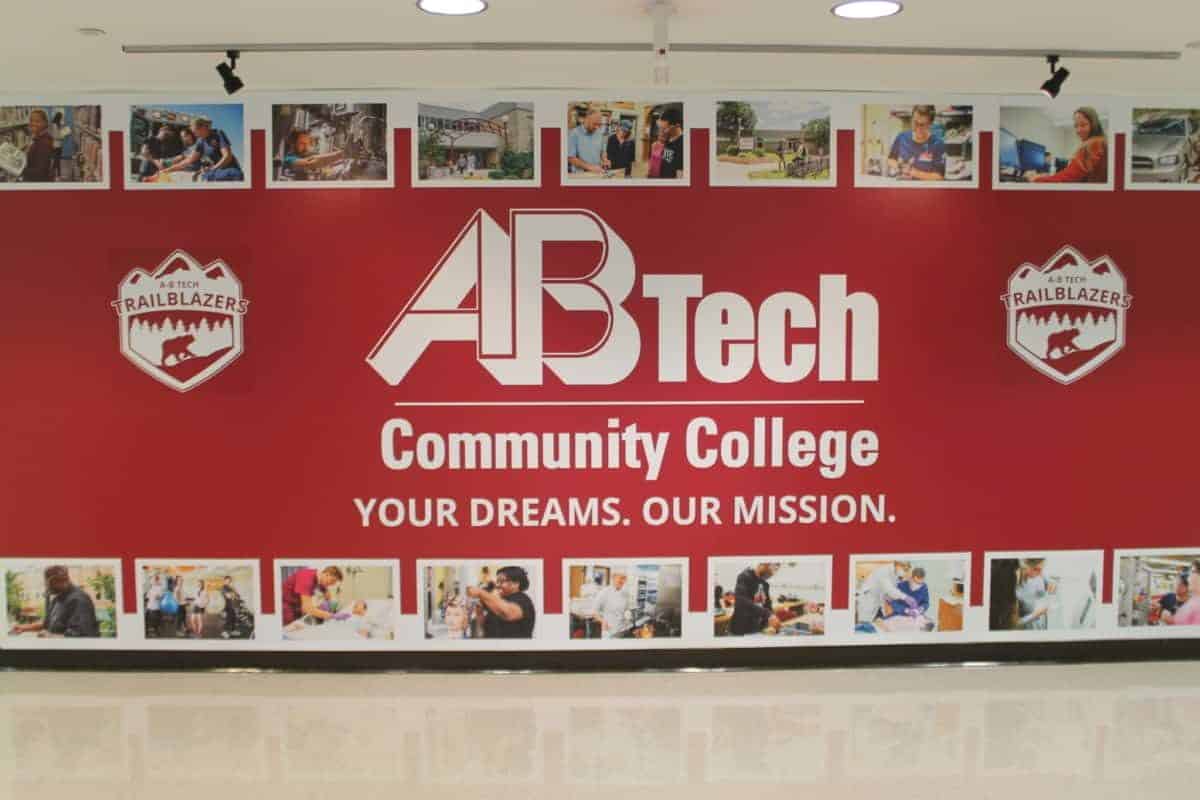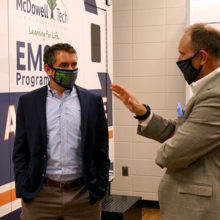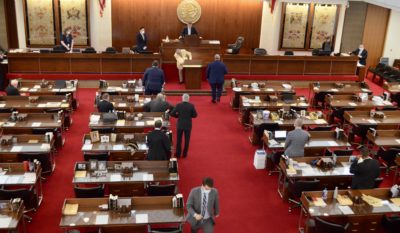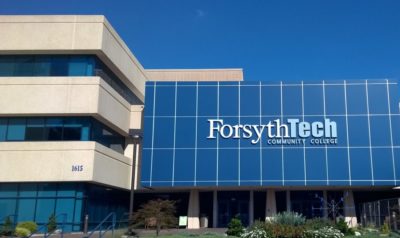

Serving as president of a community college requires many skill sets, but COVID-19 has provided a unique test for all 58 North Carolina community colleges. The response from each college has included a mix of public health, fiscal planning, personnel management, and other proficiencies.
Asheville-Buncombe Technical Community College (A-B Tech) had the added challenge of being in a leadership transition, but the college had the benefit of veteran leadership — interim president Joseph Barwick. Barwick is new to A-B Tech, but he is not new to leading a college. He served as president of Carteret Community College for 10 years.
I recently caught up with Barwick over email to discuss his tenure at A-B Tech — a tenure that will be shaped almost entirely by COVID-19.
My first question was whether his tenure at Carteret CC, where hurricanes pose frequent challenges, had shaped his leadership style and approach in this crisis. “COVID-19 is different in that it has caused all of us to change our ways of life,” Barwick said. “Houses still stand, but they have become mandatory sanctuaries. Stores still stand, but their businesses closed. Western-style education, which for centuries relied on groups of learners in the presence of teachers, has shifted to a medium of electronic connection.”
The unique challenges of a pandemic, including the uncertainty around spread and the duration of the threat, was a consistent thread throughout our conversation. Barwick pointed out that institutions have lived through a variety of upheavals in the past, but few have matched the complexities of this pandemic, particularly in the sudden transition to being fully online.
A-B Tech has addressed the range of challenges for students and staff, including:
- Establishing two nine-station facilities to provide computer access in a controlled environment to students who need it.
- Identifying parking areas that students may use for internet access from within their vehicles.
- Distributing more than 80 laptops (with more on the way) to faculty and staff to better enable them to work remotely.
- Issuing mobile hotspot devices to some employees with inadequate internet access to support teleworking.
- Deploying VPN and softphone services to allow the Information Center to continue answering calls.
- Implementing new “chat” functionality to improve customer service.
- Moving more than a million documents and files from inside the college’s network to a cloud-based location to allow employees to reach their files from home.
Even as A-B Tech grapples with current challenges, it’s beginning to plan for the summer and fall. A-B Tech will mostly serve classes online this summer, but Barwick said they now believe they can bring back small numbers of students in select programs that require face-to-face instruction. As a result, the college now plans a four-week semester to allow students to finish the spring semester.
Below is my conversation with Barwick, with minor edits for clarity and length.
Nation Hahn: As an interim president, you were new to A-B Tech, but not new to a college presidency. How do you feel your career prepared you for this unique moment?
Joseph Barwick: There are things an effective leader learns over time that can be applied, but not learned, in a crisis. The first is trust. I came into A-B Tech and immediately saw that I could trust the leadership team, not only their competence but their commitment. In a crisis, anyone who lacks the competence or tends to drift off mission would have to be moved out of the way quickly. That was not the case here.
The next thing a person learns over time that must be applied immediately is to embrace the fact that you are not the smartest person in the room. The members of the leadership team know their areas more completely than a new president could possibly learn in the few weeks we had before the crisis hit. But a president, regardless of tenure, must maintain a focus on “the big picture,” meaning not only what is best for the students, but how well actions match community needs, what is the overall impact on resources, and how to keep the Board of Trustees in the loop. Therefore, a president’s role should be to ask questions more than to give answers, and to listen more than talk.
And finally, an experienced president has a view of the college as an integrated system of parts. In a crisis, silos can be counterproductive if not outright destructive, and there is a natural tendency for people in crisis to “circle the wagons,” protecting those within their own sphere of control. The president, then, is the one all the others look to, not for answers necessarily, but to display the proper set of values, including respect, integrity, compassion, transparency and authenticity.
NH: Across our 58 community colleges we have a range of college sizes and service areas. What should the state know about our different colleges at this moment in time, and what factors do you think might vary by college during COVID-19?
JB: All 58 community colleges are student-focused and community-based. Therefore, all of us are trying to do the right things even in a crisis. But funding affects colleges differently based on size. For example, the state funding is FTE driven, meaning the more students you have this year, the more funding you will have next year. But all colleges regardless of size must have libraries, counselors, administrative personnel, and other things that support, but do not produce, FTEs. Resources for new programs and new initiatives, therefore, are hard to come by because the income produced comes in subsequent years. Now, more than ever, the smaller colleges know their mission and can look into the community and see how they need to respond to the crisis, but the resources just are not there. Larger colleges at least have the ability to shift resources to respond to new priorities — difficult, yes, but at least it is an option.
Fortunately, the federal and state governments are bringing additional funding to the colleges because of the pandemic. But, again, it will be disbursed to colleges according to size. At this time, there is no more fair mechanism in place because this question has not been posed before. What the crisis reminds us, though, is that colleges have certain baselines of services with costs not associated with size.
An example is, several decades ago our accrediting agency, SACS-COC, mandated that all colleges and universities undertake a continuous improvement model. Our community college system then added an institutional effectiveness officer position to all colleges, small as well as large. Going forward our system should perhaps look at baselines, such as technology, and determine the minimum needed to provide the most services.
NH: When did your college begin to plan its COVID-19 response? What factors, beyond the obvious health impacts, were you most concerned about from the outset?
JB: We began talking about, and monitoring, COVID-19 in early March. On March 10, the VP of instruction held a meeting with her deans, directors, and faculty telling them to begin preparing to go all online for instruction. That afternoon, the college hosted a meeting with Gov. Cooper in which he outlined the severity of the pandemic and steps that are necessary to combat it. On March 13, the college leadership team and other key personnel held the first COVID-19 Communications Task Force meeting hosted by the VP of finance and operations to discuss and plan our responses. These meetings immediately transformed into Zoom meetings and have been held daily.
Our first concern, of course, was health and safety of students and employees. Next, we were concerned about shifting instruction to an online format in the time allowed and due to an external threat as opposed to a well-thought-out plan to improve access or quality. Would our technology infrastructure support it? Would our communities with limited broadband be able to access it? Would our students be willing to make the change?
NH: Would you share some details on the logistics required to respond to COVID-19?
JB: In terms of the welfare of our employees, we immediately began revising all employee benefit policies, increasing flexibility with type and extent of leave, emergency pay, telework procedures, and more. All of these were approved internally and by the Board of Trustees.
Our Instructional Technology staff made changes to our infrastructure to maximize our technology resources to bring more students online, increase traffic to our instructional delivery systems, make Zoom a standard venue for most meetings, and developed a student Emergency Computer Lab with all disinfectant and distancing protocols.
We began deploying “hot spots” at our campuses where students could access the internet from their cars; and our Student Services area, along with many volunteers, began personally contacting students (around 4,000 at last count) to see how they are doing, to direct them to resources, and encourage them to stay in the game.
NH: What did the process to move courses online look like for A-B Tech? What unexpected roadblocks did you all run into?
JB: I can’t say that any of the roadblocks were unexpected. People should understand that the NC college system was founded on technical education, not junior college education. That is why A-B Tech, although it was a junior college, maintained the “Technical” as part of its name when it became a community college.
That said, we knew that much of our instruction was hands on, requiring a physical presence of both the student and the instructor. I would say the unexpected part was the creativity and ingenuity our technical faculty showed in coming up with ways to enable students to pursue those skills in light of required hygiene and distancing protocols. In our medical programs, students are required to do a prescribed amount of clinical hours, and some of those clinics closed to all but essential personnel, forcing our students out. We have been able to shift some clinical sites, but some students will have to double up clinical time when the doors open again.
On the other side, there are some places that truly need our students at this time because their training is advanced enough to provide relief to the regular medical care staff. There are also courses, such as cosmetology and barbering, that require a minimum number of contact hours that the students must be present to complete. Some boards have given us permission to use a technology such as Zoom to provide oversight on the students’ work, at least for some of the hours, but, again, adjustments will have to be made once the students can come back as a group onto campus. Our success is evident in the student responses to our personal outreach efforts and a survey posted on our website. They appreciate the effort that is going into our commitment to not interrupt their education and are making an effort themselves.
NH: What is the level of internet connectivity for your service area?
JB: Everyone who has ever worked in a community college is well aware of the socioeconomic and education gaps that divide our students into those who have and those who do not. Then you add in a technology gap. You might think that the technology gap is just a product of the others, but it is more than that. Some students have had technology as part of their lives since they were born, and they were also able to keep up with the technological advancements as they occurred. Others might have a smartphone and maybe an iPad, but accessing all education online is a great stretch. That is why we have really pushed our services to meet students online, by phone, email or chat, and help them through the deeper, more complex, challenges.
NH: What efforts have you undertaken to maintain student and faculty engagement since you transitioned courses online?
JB: Leaders throughout the college have used block emails and Zoom to reach out to employees, and I, as president, have sent a separate Zoom message of appreciation to our maintenance and custodial staff and to our police force. These groups have been required as essential workers to continue to come to campus. I have also sent a message of appreciation to all employees and one of encouragement to all students. In addition, the college has transitioned its professional development seminars to webinars and has included many on health and wellness. Our VP of instruction has a weekly Zoom meeting with all who report through her, and they conclude each meeting with an exercise that everyone enjoys that takes the “pulse” of everyone’s emotional/mental state.
NH: Could you share more about A-B Tech’s approach to workforce development courses during COVID-19?
JB: The governor has said, and our counties have agreed, that higher education is an essential business and we should identify those programs that are important for the economy and, ultimately, for the recovery. Therefore, we are continuing things like contract training, workplace learning, and other things that directly impact worker skills. Our AVL Technologies Small Business Center never ceased its operations during the crisis; rather it shifted to technology delivery methods, continued to develop webinars, and found additional resources for our regional entrepreneurs. Our partnership with the Belk and NCSU-sponsored StartUp Asheville project is a major step forward in helping our small businesses, which I believe will be the business sector with the greatest impact on the speed and prosperity of our recovery. We have also reopened our Adult High School and GED programs because having the high school credential is going to be more important than ever.
NH: What makes you optimistic during this unprecedented time?
JB: People will look back on the time of COVID-19 as a watershed event that pushed everyone not only out of their comfort zone but into a zone heretofore unnamed. They did not merely survive it, they prevailed. They all learned what they had to learn, in order to do what they had to do, in order to continue to be what they are — A-B Tech Community College.
NH: What keeps you up at night?
JB: Worrying about the long-range impact of this transformation on the college. A-B Tech was a leader in the “Invitational College” movement and as such has ingrained in the college culture, R.I.S.E. – Respect, Integrity, and Support for Everyone. All colleges strive to create a welcoming social and professional environment, but few succeed as well as A-B Tech. What will this long period of isolation and separation do to that culture?
NH: What concerns do you have for community colleges as we look to the fall? Obviously COVID-19 impacts remain uncertain, but I am curious to know what you and your leadership team are grappling with as you all look ahead.
JB: I know that some pundits are saying some colleges and universities might not survive this crisis. But the North Carolina community colleges were formed by the Omnibus Higher Education Act in 1963 specifically to transform the state into a new economy. Our colleges are change agents, and we will continue — with whatever resources, despite whatever crises — to move our students, our communities, and our state forward. We have moved in a matter of days from a robust and prosperous economy to one of devastating closures and rollbacks. We are potentially looking at austere funding worse than the recession, and we are looking at new challenges to lead students back into an educational trajectory that promises greater, but delayed, rewards. But we have a mission, and we will not lose sight of it.
NH: What are your specific plans for the fall semester?
JB: We are employing the old cliche, “Plan for the best; prepare for the worst.” Our best will be if students can return to campuses in large numbers. In planning for that, we are looking at virtually all safety protocols and procedures that are practicable in an environment that includes people. But we are also preparing for a fall semester that continues a stay-home order. We learned that many of our students who had to drop out did so for life changes more than course delivery changes. Loss of income, childcare, a job to go to … these things took a tremendous toll on our students as they have on everyone. One of the things we are talking about is how to “humanize” our online classes. When students who are potential dropouts are asked why they persisted, they will almost always refer to a person or persons at the college who reached them. When the crisis hit, A-B Tech converted from a person-to-person college to an online college in two weeks. Student surveys affirm that we did it effectively. But now we have the opportunity to do it better and bring the technology closer to what students expect in a relationship with a teacher. So if in the fall we are still working and learning from home, we will be better at that than ever.
NH: The disbursement of CARES Act funding has generated a lot of conversation in community college circles. What are A-B Tech’s current plans for the funding?
JB: As of today we have still not received the student aid part of the CARES Act funds coming from the Department of Education. However, our intent is to put these funds into the hands of students immediately when we do. Like other colleges, we waited for guidelines either from the Feds or from the community college system, but we continued to find more questions than answers. This is where a leader needs to be comfortable with ambiguity! We are, so we are moving forward in order to be ready. As we understand the guidelines, eligible students are those who meet Title IV criteria to apply for federal financial aid. If students have applied for financial aid during the 2019-2020 school year, and were enrolled as of March 9, they automatically meet those criteria, and we know of about 2,300 students who have. We also have identified about 2,000 more who meet the criteria but did not complete the application for financial aid (FAFSA). When we receive the money, we will immediately disburse an equal share to the 2,300. Then we will make a personal appeal to the other 2,000 to complete the FAFSA before June 30 in order to receive their equal shares. Some colleges will use other processes, such as a sliding scale tied to number of hours enrolled. Others will tie it to demonstrated need. At AB Tech, we believe the money was intended for students to use for living expenses, such as rent, power, groceries, to help them during this time of crisis. We also believe it is not our role to attempt to determine which students were hurt the most or whose lives are most precarious. Therefore, we accept the DOE gesture in the spirit we believe it was offered and hope it provides some relief to the students who receive it.
The second block of CARES Act funding will come to the college for the college to use to offset expenses incurred as a result of COVID-19. We still do not know the full extent of those costs but we are compiling them now. What we do know is that the students who were forced to withdraw from classes due to the pandemic should be made whole if possible. We cannot offer them tuition refunds due to state regulations on the use of state funds. We think, however, that we can use the second block of CARES money to pay for the courses if they retake them in summer or fall. We also believe we can use these funds to pay teachers to come back in the summer to enable students to finish.
When we entered this crisis, we made a commitment to protect positions and paychecks. So far we have honored that commitment. We are hoping that the institutional aid half of the CARES Act will enable us to continue that commitment through the summer.




